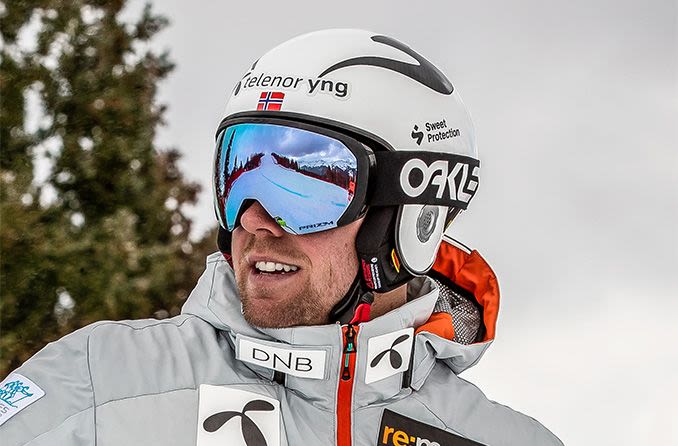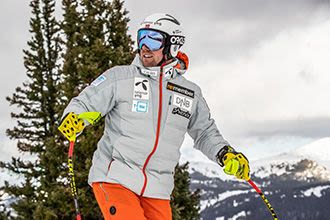Which sunglasses and goggles are best for snow skiing?

If you ski, you know a good pair of goggles can make or break you — not literally (we hope!). On a sunny day, sunlight bouncing off glaring white snow can erase depth and contrast.
Skiing at night, you’re dealing with the opposite problem: trying to spot details on the darkened slopes whipping by beneath your skis.
One little mogul or ice patch not spotted in time can bring you down fast.
If you’re new to skiing or a bit out of practice, you want to make sure your eyes are doing their best to help you avoid mishaps. And if you’re skiing the black diamond trails — well, goggles can make all the difference.
In fact, Aleksander Aamodt Kilde, a World Cup alpine ski racer from Norway, says goggles may be the most important accessory you can buy. As a professional athlete, he knows the most important things to look for in a pair of ski goggles are visibility, comfort and style.
Best sunglasses for championship skiers
How important are goggles when you’re racing down alpine slopes? “It would be impossible to ski without goggles at the speed I’m going, about 90 miles per hour,” Kilde says. “So goggles might be one of the most important factors.”
Kilde travels down the mountain a lot faster than most of us ever will, so he puts his eyewear to the ultimate test. “I need to be able to make out my path clearly and make split-second decisions at high velocity,” Kilde says. “Clear vision is, of course, a must.”

His specialty is the heart-stopping Super-G, a slalom race performed on a super-steep incline that involves quick maneuvers at breakneck speeds. You may remember watching Kilde during the 2014 Winter Olympics held in Sochi, Russia, where the vertical drop of the Super-G course was a whopping 622 meters (2,041 feet).
He’s been building a reputation on the World Cup circuit ever since.
“When you’re racing and increasing speed and changing direction at pace, there’s minimal time to react to the environment,” Kilde says. “I rely on my vision to get me safely down the mountain.”
So, what does an alpine racer look for when he’s shopping ski goggles?
“When buying eyewear for my sport, I look for a few things,” Kilde says. Primary among them: visibility, comfort, and style — in that order. Kilde advises skiers to look for goggles that provide:
Good visibility in a variety of conditions
Comfortable fit for all-day wear
Style and shape to fit individual preferences
SEE RELATED: Blind Athletes in the Paralympic and Olympic Games
Why skiers need excellent visibility
“I look for good visibility in all kinds of light and weather,” Kilde says. If you ski, you’re dealing with wind, possibly snow or ice blowing into your eyes, and light conditions that can alter dramatically from one moment to the next.
When Kilde plays outside in the snow with his pup, he wears Oakley Latch sunglasses with matte black frames and polarized lenses. On the slopes, it’s a different story.
Like most pros, Kilde requires goggles that allow him to replace the lens quickly as needed. These days he’s wearing Oakley’s soon-to-be-released Flight Path XL goggles, an update of his former go-to, the Oakley Canopy. “I worked closely with Oakley on the design to incorporate key functions I demand when performing,” Kilde says.
Flight Path XL has the brand’s Ridgelock EV lens-changing system, which extends the upper field of view for increased visibility and allows for swift lens replacement.
“Now I can change out my goggles’ lenses pending weather conditions and use different Prizm lenses that were created for those environments,” Kilde says.
Like other Oakley ski goggles, Flight Path XL sports a spherical lens that curves horizontally and vertically around your face, allowing better peripheral vision and less glare, fogging and distortion.
Prizm Snow lenses are designed to detect depth and contrast in wintery environments, transforming a snowy mountain from powdery chaos to a manageable run — something like this — while you’re speeding down the pass.
Prizm Snow lenses come in a number of colors, including several with Oakley’s Iridium coating for a smoother transition between changing light conditions: pink for low-light and overcast days; black for bright sunlight; and orange, green and blue for sun and clouds. You can guess the weather conditions by the color lens Kilde is wearing in his Instagram posts: He favors iridium lenses in torch and sapphire.
Smith also makes well-reviewed ski goggles with spherical lenses. Their new 4D Mag features a magnetic lens-change system with a new lens shape called BirdsEye Vision. The lower portion of the lens curves inward, which Smith claims increases downward visibility by 25%. If you ski on uneven terrain, this may be worth checking out.
Anon Sync goggles — which include smaller sizes specifically designed for women — have a cylindrical lens that curves horizontally around the face but is vertically flat. Zeiss designs its Sonar lens to enhance contrast and depth of terrain, with an anti-fog treatment and magnetic latch system that allows you to change the lens quickly and easily.
Best goggles for flat light
A major challenge for skiers is what they call flat light, when snowfall or clouds block the sunlight from reaching the ground, making it difficult (and dangerous) to see the texture of the snow.
“I have had moments when the light has been so flat I haven’t been able to see the contrasts,” Kilde says, “but I never had an issue with the sun hitting the face.”
Lenses in the best ski goggles are designed to precisely control the percentage of light that can pass through, a measurement known as Visible Light Transmission or VLT.
Lenses for skiing in low light or limited visibility, for example, are usually yellow or rose, sometimes blue, and allow about 60% to 90% of the light through. These lenses should help you out in flat light and low visibility, such as when it’s snowing or foggy.
SEE RELATED: Best sunglasses for skiing (product version)
Can you get prescription ski goggles?
If you ski or snowboard and need corrective eyewear, you have a few options. If you primarily wear eyeglasses, it’s possible to wear ski goggles over your glasses, but you’ll want as tight a fit as possible to avoid steaming up both sets of lenses — not a good outcome!
Many skiers and snowboarders prefer to wear contact lenses under their ski goggles. If you can wear contacts, they’re probably your most cost-effective and convenient option, especially if you expect to change out lenses for changing light conditions.
If you can’t wear contacts, try goggles on in-store over your glasses. If you have to size up, make sure the goggles fit as closely to your face as possible and that any air vents are clear.
If you’re a serious skier, it may be worth “converting” your ski goggles with prescription inserts or adaptors. A ski goggle lens is one piece, so ski goggles and sunglasses use inserts or adaptors to make them prescription-strength. This means you may be able to retrofit existing goggles.
Prescription ski and snow goggle inserts and adaptors are offered by Smith, Oakley, Anon and SPY, but only a limited number of goggle and sunglass models can integrate with them. Ask your optician for recommendations.
What to avoid when shopping ski goggles
A foggy lens is the most dangerous trick a goggle can play when you’re speeding down the slopes. Kilde recommends paying a little more for a goggle that fits you comfortably but snuggly.
Avoid overly cheap, badly constructed goggles, if you can. “They tend to fog up quickly which inhibits vision,” Kilde says, “and they come with one standard lens that you can’t switch out when you need to due to shifting weather conditions.”
Whatever you do, wear something to protect your eyes when you’re on those slopes, even for a casual afternoon run.
“Eyes are not replaceable, so skiing without a goggle is never a good idea,” Kilde says. “A good goggle and lens makes skiing a lot more fun.”
KNOW WHICH SKI GOGGLES YOU WANT? Before you hit the slopes, shop for sunglasses at an optical store near you or an online eyewear retailer.
Page published on Tuesday, February 25, 2020




